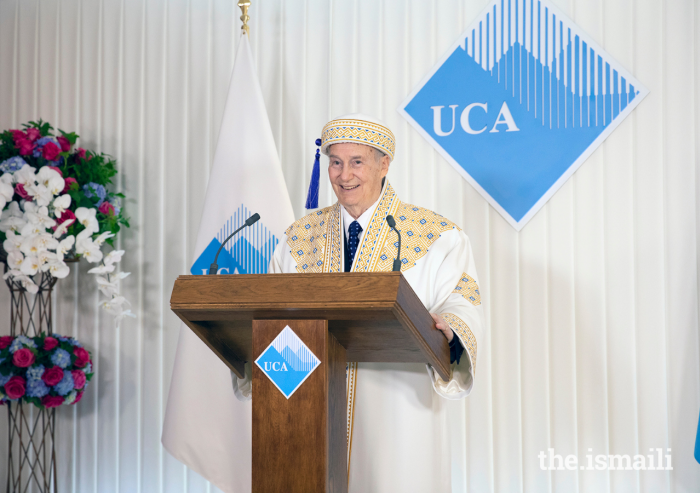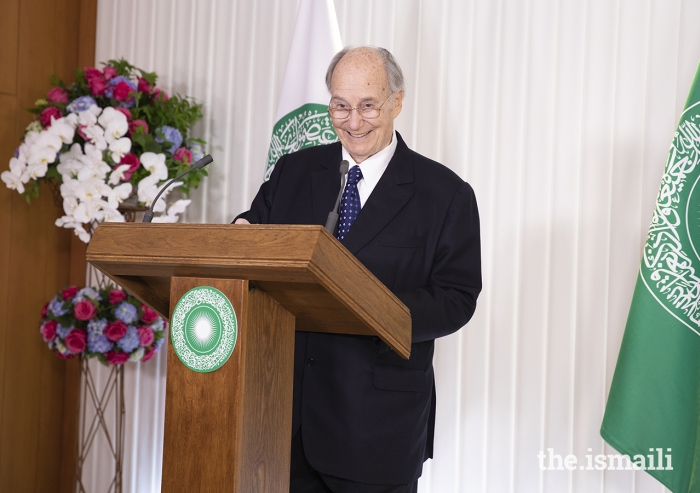
Aga Khan Award for Architecture Ceremony, Granada
Your Majesties
Mr. President
Your Excellencies
Distinguished Guests
It is my distinct pleasure to open the 1998 Award Presentation Ceremony of the Aga Khan Award for Architecture. It is an honour to do so in the presence of Their Majesties the King and Queen of Spain, and a privilege to welcome them, and all of you, here this evening. I would like to take special note of the largest contingent of ministers of governments from the Islamic world ever to attend this event. I interpret their presence as an expression of interest and commitment to the thoughtful process of physical change in their societies.
The triennial Presentation Ceremony of the Award for Architecture is the culmination of a careful, comprehensive, and intense effort to identify building projects worthy of world-wide attention in Islamic societies. Tonight we will celebrate the achievements represented by the seven projects selected this year. This evening’s occasion has special significance in that it marks the completion of the Award’s first twenty years. We are therefore especially grateful for Your Majesties’ presence, and for your support, that of the Royal Household, the Spanish Government, and the Government of Andalusia in making it possible to celebrate this occasion in this remarkable setting.
Each Award Presentation Ceremony has been held in a setting of special significance in the history of Islamic architecture. The Alhambra Palace is in the very best of this tradition, and I would like to thank its Administration and the Municipality of Granada for their assistance in the arrangements for all of the activities here today. This exceptional expression of the genius of Islamic buildings and gardens is beautifully presented and maintained, a credit to all those responsible for its management, and indicative of the respect for culture and architecture, in its richness and diversity, that is so enthusiastically embraced here in Spain.
For the first time the Award Presentation Ceremony is being held in Western Europe. Spain’s example of successful cultural pluralism, reaching back into all chapters of its history, and out to the diverse array of countries in the region, including an important part of the Islamic world, makes this a particularly appropriate and inspiring setting.
Under His Majesty King Juan Carlos’s wise and foresighted leadership, Spain’s bridging role between Europe and the Ummah is being enhanced to the benefit of both.
Having completed twenty years – a generation in human terms- it is appropriate to offer some observations on the Award’s record. The decision to create the Award stemmed from a sense that Islamic societies had lost some extraordinary inheritance in domain of human creativity in which they once set standards for the rest of the world. Skill, knowledge, and vision in the realm of architecture were once a hallmark of Islamic civilisations, and central to the identity of its peoples. The overarching goal of the Award is to stimulate the reawakening of that inheritance, and nurture its continuing evolution in contemporary terms, by seeking examples of creative solutions to the wide range of needs for buildings and public spaces.
The Master Juries – appointed anew for each cycle, and completely independent in their work – have brought many remarkable projects to the attention of the wider public, and have created what is now a continuing discourse about architecture appropriate for Muslim communities as they confront the modern world. This year’s Jury, whom I would like to take this opportunity to commend and thank for their work, has made its own distinctive contribution to this process. The results of its decision to search for projects with a wide global context and meaning, as well as those with regional significance, has yielded a rich and interesting mixture of Award winning projects.
Collectively the seventy-six projects selected for premiation over the last twenty years share a celebration of the humanity of inspired architecture, and confirm the potential of its social purposes. They are also distinguished by the pluralism of the cultures of the Islamic world in which they are rooted, a pluralism that all Master Juries have both honoured and trusted. This richness of cultural expression is even more fully documented in the materials collected on the hundreds of projects considered but not selected in each cycle of the Award.
But what are the prospects for the pluralism of cultures in the Islamic world, their richness of expression, and their contributions to world culture as one looks ahead over the next twenty to forty years? On the basis of my extensive travels as Imam of the Shia Ismaili Muslims or in connection with the activities of the Aga Khan Development Network, I think there are grounds for serious concern.
Rapidly expanding populations, increasing environmental degradation, and the unevenness of development and resources, all contribute to the growth of an underclass that has never had sufficient opportunity or support for participation in cultural activities. More recently, the seemingly universal increase of migration to the cities, and the tragedy of dislocated populations seeking refuge from civil strife in many parts of the world have brought further pressure. Both of these processes remove people from familiar surroundings and thrust them into the unknown in terms of culture. Finally, there is the avalanche of new images, whether projected by the modern global electronic media, or by more traditional orthodoxies that make hegemonic claims with new vigour in response to it. Both are very powerful forces, both are monopolistic in intent, and neither nurtures or even respects pluralism.
In conclusion I would offer several propositions based on lessons drawn from the experience of the Aga Khan Award for Architecture. They are relevant to its future work, and perhaps, more globally, to the process of cultural development and change.
- The loss of our inheritance of cultural pluralism – the identity it conveys to its members of diverse societies, and the originality it represents and stimulates in all of them – will impoverish our societies now and into the future.
- Sustaining this inheritance will require conscious and concerted effort involving the best minds and most creative institutions around the world.
- This effort must be grounded in an informed understanding of history and cultural context, and yet be forward looking and imaginative as it addresses the needs of contemporary societies.
- It will require an enabling environment, characterised by open and unfettered debate of ideas, a trust in cultural diversity, the celebration and reward of innovation, and a commitment to civil society and pluralistic government.
- It will also necessitate that the cultures of the developing world establish a presence on the rapidly growing information superhighway to balance those that currently dominate the new electronic media. This will require an investment of time and resources and a mastery of regional and international languages. Unless these cultures develop creditable and creative ways to present themselves effectively in this new and powerful medium of communication, cultural pluralism will suffer a massive setback.
Your Majesties, Mr. President, Your Excellencies, Distinguished Guests, the search started by the Aga Khan Award for Architecture twenty years ago will continue. It will remain committed to learning and sharing what is learned. Although its focus is Islamic societies, its quest is to develop knowledge and understanding that is outward looking and universal in nature. It is in that very spirit, that I am grateful for your presence here tonight.
Thank you.







